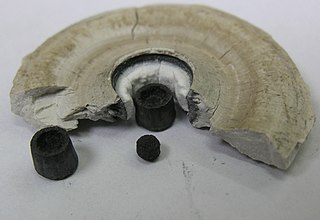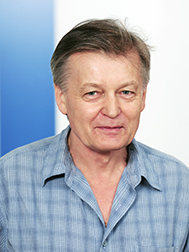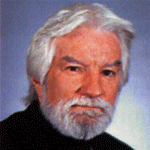Related Research Articles

Superconductivity is a set of physical properties observed in certain materials where electrical resistance vanishes and magnetic fields are expelled from the material. Any material exhibiting these properties is a superconductor. Unlike an ordinary metallic conductor, whose resistance decreases gradually as its temperature is lowered, even down to near absolute zero, a superconductor has a characteristic critical temperature below which the resistance drops abruptly to zero. An electric current through a loop of superconducting wire can persist indefinitely with no power source.

High-temperature superconductors are defined as materials with critical temperature above 77 K, the boiling point of liquid nitrogen. They are only "high-temperature" relative to previously known superconductors, which function at even colder temperatures, close to absolute zero. The "high temperatures" are still far below ambient, and therefore require cooling. The first break through of high-temperature superconductor was discovered in 1986 by IBM researchers Georg Bednorz and K. Alex Müller. Although the critical temperature is around 35.1 K, this new type of superconductor was readily modified by Ching-Wu Chu to make the first high-temperature superconductor with critical temperature 93 K. Bednorz and Müller were awarded the Nobel Prize in Physics in 1987 "for their important break-through in the discovery of superconductivity in ceramic materials". Most high-Tc materials are type-II superconductors.
Metallic hydrogen is a phase of hydrogen in which it behaves like an electrical conductor. This phase was predicted in 1935 on theoretical grounds by Eugene Wigner and Hillard Bell Huntington.
Palladium hydride is palladium metal with hydrogen within its crystal lattice. Despite its name, it is not an ionic hydride but rather an alloy of palladium with metallic hydrogen that can be written PdHx. At room temperature, palladium hydrides may contain two crystalline phases, α and β. Pure α-phase exists at x < 0.017 while pure β-phase exists at x > 0.58; intermediate x values correspond to α-β mixtures.
The Schön scandal concerns German physicist Jan Hendrik Schön who briefly rose to prominence after a series of apparently successful experiments with semiconductors that were discovered later to be fraudulent. Before he was exposed, Schön had received the Otto-Klung-Weberbank Prize for Physics and the Braunschweig Prize in 2001, as well as the Outstanding Young Investigator Award of the Materials Research Society in 2002, all of which were later rescinded.
A room-temperature superconductor is a hypothetical material capable of displaying superconductivity at temperatures above 0 °C, which are commonly encountered in everyday settings. As of 2023, the material with the highest accepted superconducting temperature was highly pressurized lanthanum decahydride, whose transition temperature is approximately 250 K (−23 °C) at 200 GPa.

Covalent superconductors are superconducting materials where the atoms are linked by covalent bonds. The first such material was boron-doped synthetic diamond grown by the high-pressure high-temperature (HPHT) method. The discovery had no practical importance, but surprised most scientists as superconductivity had not been observed in covalent semiconductors, including diamond and silicon.
In condensed matter physics, the resonating valence bond theory (RVB) is a theoretical model that attempts to describe high-temperature superconductivity, and in particular the superconductivity in cuprate compounds. It was first proposed by an American physicist P. W. Anderson and Indian theoretical physicist Ganapathy Baskaran in 1987. The theory states that in copper oxide lattices, electrons from neighboring copper atoms interact to form a valence bond, which locks them in place. However, with doping, these electrons can act as mobile Cooper pairs and are able to superconduct. Anderson observed in his 1987 paper that the origins of superconductivity in doped cuprates was in the Mott insulator nature of crystalline copper oxide. RVB builds on the Hubbard and t-J models used in the study of strongly correlated materials.

Mikhail Ivanovich Eremets is an experimentalist in high pressure physics, chemistry and materials science. He is particularly known for his research on superconductivity, having discovered the highest critical temperature of 250 K (-23 °C) for superconductivity in lanthanum hydride under high pressures. Part of his research contains exotic manifestations of materials such as conductive hydrogen, polymeric nitrogen and transparent sodium.
A polyhydride or superhydride is a compound that contains an abnormally large amount of hydrogen. This can be described as high hydrogen stoichiometry. Examples include iron pentahydride FeH5, LiH6, and LiH7. By contrast, the more well known lithium hydride only has one hydrogen atom.
Egor Babaev is a Russian-born Swedish physicist. In 2001, he received his PhD in theoretical physics from Uppsala University (Sweden). In 2006 he joined the faculty of the KTH Royal Institute of Technology in Stockholm. In 2007-2013 he shared this position with a faculty appointment at Physics Department of the University of Massachusetts, Amherst (USA). He is currently full professor at the Physics Department KTH Royal Institute of Technology.
Lanthanum decahydride is a polyhydride or superhydride compound of lanthanum and hydrogen (LaH10) that has shown evidence of being a high-temperature superconductor. It was the first metal superhydride to be theoretically predicted, synthesized, and experimentally confirmed to superconduct at near room-temperatures. It has a superconducting transition temperature TC around 250 K (−23 °C; −10 °F) at a pressure of 150 gigapascals (22×106 psi), and its synthesis required pressures above approximately 160 gigapascals (23×106 psi).

Paul Michael Grant was an American/Irish physicist and science writer who was involved in discovering and elucidating the structure of Yttrium Barium Copper Oxide which was important as the first high temperature superconductor to exhibit superconductivity above the boiling point of Nitrogen. He was a co-author of IBM's US patent application covering their preparation.
In chemistry, a hydridonitride is a chemical compound that contains hydride and nitride ions in a single phase. These inorganic compounds are distinct from inorganic amides and imides as the hydrogen does not share a bond with nitrogen, and contain a larger proportion of metals.
Carbonaceous sulfur hydride (CSH) is a potential superconductor that was announced in October 2020 by the lab of Ranga Dias at the University of Rochester, in a Nature paper that was later retracted. It was reported to have a superconducting transition temperature of 15 °C (59 °F) at a pressure of 267 gigapascals (GPa), which would have made it the highest-temperature superconductor discovered. The paper faced criticism dut to its non-standard data analysis calling into question its conclusions, and in September 2022 it was retracted by Nature. In July 2023 a second paper by the authors was retracted from Physical Review Letters due to suspected data fabrication, and in September 2023 a third paper by the authors about N-doped lutetium hydride was retracted from Nature.
Uranium ditelluride is an inorganic compound with the formula UTe2. It was discovered to be an unconventional superconductor in 2018.

LK-99, also called PCPOSOS, is a gray–black, polycrystalline compound, identified as a copper-doped lead‒oxyapatite. A team from Korea University led by Lee Sukbae (이석배) and Kim Ji-Hoon (김지훈) began studying this material as a potential superconductor starting in 1999. In July 2023, they published preprints claiming that it acts as a room-temperature superconductor at temperatures of up to 400 K at ambient pressure.
References
- ↑ Garisto, Dan (March 9, 2023). "Allegations of Scientific Misconduct Mount as Physicist Makes His Biggest Claim Yet". Physics. 16: 40. Bibcode:2023PhyOJ..16...40G. doi: 10.1103/Physics.16.40 . S2CID 257615348 . Retrieved March 24, 2023.
- ↑ "Superconductor Now a Reality at Room Temperature -- But Not Room Pressure". Inside Science. October 14, 2020. Retrieved March 24, 2023.
- 1 2 3 Magazine, Undark (March 27, 2023). "A Potential Triumph in Physics, Dogged by Accusation and Doubt". Undark Magazine. Retrieved April 3, 2023.
- 1 2 3 4 Bushwick, Sophie. "Controversy Surrounds Blockbuster Superconductivity Claim". Scientific American. Retrieved April 3, 2023.
- 1 2 Garisto, Dan (2023). "'A very disturbing picture': another retraction imminent for controversial physicist". Nature. 620 (7972): 14–16. Bibcode:2023Natur.620...14G. doi:10.1038/d41586-023-02401-2. PMID 37491414. S2CID 260162594 . Retrieved July 26, 2023.
- 1 2 3 Staff, CT (July 23, 2023). "University professor sees second paper retracted under accusations of data fabrication". Campus Times. Retrieved July 26, 2023.
- 1 2 Garisto, Dan. "Controversial Physicist Faces Mounting Accusations of Scientific Misconduct". Scientific American. Retrieved July 29, 2023.
- 1 2 Chang, Kenneth (July 26, 2023). "A Looming Retraction Casts a Shadow Over a Field of Physics". The New York Times. Retrieved July 29, 2023.
- 1 2 Subbaraman, Nidhi (March 20, 2024). "Superconductor Scientist Engaged in Research Misconduct, Probe Finds". Wall Street Journal.
- ↑ Castelvecchi, Davide (November 7, 2023). "Nature retracts controversial superconductivity paper by embattled physicist". Nature. doi:10.1038/d41586-023-03398-4. ISSN 0028-0836. PMID 37935863.
- 1 2 "Retraction Watch Database". Retraction Watch. Crossref. Retrieved March 12, 2024.
- ↑ Chant, Tim De (March 17, 2023). "Unearthly Materials claimed to have big-name investors, but they weren't all on board". TechCrunch. Retrieved March 24, 2023.
- 1 2 Bresnick, Sam. "Brain behind Metallic Hydrogen: Pressing on Pressure". Daily News. Retrieved April 3, 2023.
- ↑ "Bio". scholar.harvard.edu. Retrieved April 3, 2023.
- ↑ Subba, Sanghamitra (March 8, 2021). "UR Professor Ranga Dias has brought the world one step closer to hoverboards and magnetic levitation trains". Campus Times. Retrieved April 3, 2023.
- 1 2 3 Kariyawasam, Dilshani (December 8, 2020). "Sri Lankan-lead team discovers world's first room-temperature superconductor". Colombo Gazette. Retrieved April 3, 2023.
- ↑ "ORCID". orcid.org. Retrieved March 24, 2023.
- ↑ Wolcott, R.J. (March 12, 2021). "WSU graduate recognized as Time100 Next innovator". WSU Insider. WSU News. Retrieved March 24, 2023.
- ↑ "Harvard Scholar Bio". scholar.harvard.edu. Retrieved March 24, 2023.
- ↑ "Advance in high-pressure physics". Harvard Gazette. January 26, 2017. Retrieved January 4, 2018.
- ↑ Amos, Jonathan (2017). "Hydrogen 'wonder material' claim made". BBC News. Retrieved January 4, 2018.
- ↑ Flores, Felipe. "The Discovery of Metallic Hydrogen – Harvard Science Review". harvardsciencereview.com. Retrieved March 4, 2019.
- ↑ Castelvecchi, Davide (February 2, 2017). "Physicists doubt bold report of metallic hydrogen". Nature. 542 (7639): 17. Bibcode:2017Natur.542...17C. doi: 10.1038/nature.2017.21379 . PMID 28150796.
- ↑ "New Faculty 2017–2018". www.rochester.edu. Retrieved April 3, 2023.
- ↑ Silvera, Isaac F.; Dias, Ranga (January 1, 2021). "Phases of the hydrogen isotopes under pressure: metallic hydrogen". Advances in Physics: X. 6 (1): 1961607. Bibcode:2021AdPhX...661607S. doi: 10.1080/23746149.2021.1961607 . S2CID 238638324.
- ↑ Snider, Elliot; Dasenbrock-Gammon, Nathan; McBride, Raymond; Debessai, Mathew; Vindana, Hiranya; Vencatasamy, Kevin; Lawler, Keith V.; Salamat, Ashkan; Dias, Ranga P. (October 1, 2020). "RETRACTED ARTICLE: Room-temperature superconductivity in a carbonaceous sulfur hydride". Nature. 586 (7829): 373–377. Bibcode:2020Natur.586..373S. doi:10.1038/s41586-020-2801-z. ISSN 1476-4687. OSTI 1673473. PMID 33057222. S2CID 222823227. (Retracted, see doi:10.1038/s41586-022-05294-9, PMID 36163290 )
- ↑ Dias, Ranga P.; Silvera, Isaac F. (February 17, 2017). "Observation of the Wigner-Huntington transition to metallic hydrogen". Science. 355 (6326): 715–718. arXiv: 1610.01634 . Bibcode:2017Sci...355..715D. doi:10.1126/science.aal1579. ISSN 0036-8075. PMID 28126728. S2CID 52851498.
- ↑ Dias, Ranga P.; Noked, Ori; Silvera, Isaac F. (April 8, 2016). "New Phases and Dissociation-Recombination of Hydrogen Deuteride to 3.4 Mbar". Physical Review Letters. 116 (14): 145501. arXiv: 1510.05686 . Bibcode:2016PhRvL.116n5501D. doi:10.1103/PhysRevLett.116.145501. PMID 27104717. S2CID 115503.
- 1 2 3 Dasenbrock-Gammon, Nathan; Snider, Elliot; McBride, Raymond; Pasan, Hiranya; Durkee, Dylan; Khalvashi-Sutter, Nugzari; Munasinghe, Sasanka; Dissanayake, Sachith E.; Lawler, Keith V.; Salamat, Ashkan; Dias, Ranga P. (March 1, 2023). "Evidence of near-ambient superconductivity in a N-doped lutetium hydride". Nature. 615 (7951): 244–250. Bibcode:2023Natur.615..244D. doi:10.1038/s41586-023-05742-0. ISSN 1476-4687. PMID 36890373. S2CID 257407449. (Retracted, see doi:10.1038/s41586-023-06774-2, PMID 37935926 )
- ↑ Dasenbrock-Gammon, Nathan; McBride, Raymond; Yoo, Gyeongjae; Dissanayake, Sachith; Dias, Ranga (September 1, 2022). "Second harmonic AC calorimetry technique within a diamond anvil cell". Review of Scientific Instruments. 93 (9): 093901. arXiv: 2206.10072 . Bibcode:2022RScI...93i3901D. doi:10.1063/5.0104705. ISSN 0034-6748. PMID 36182513. S2CID 249889303.
- ↑ Wolcott, R. J. "WSU graduate recognized as Time100 Next innovator". WSU Insider. Retrieved April 3, 2023.
- ↑ "2021 TIME100 Next: Ranga Dias". Time. February 17, 2021. Retrieved April 3, 2023.
- ↑ Bushwick, Sophie. "Controversy Surrounds Blockbuster Superconductivity Claim". Scientific American. Retrieved March 24, 2023.
- ↑ "'Revolutionary' blue crystal resurrects hope of room temperature superconductivity". www.science.org. Retrieved March 24, 2023.
- ↑ Wood, Charlie. "Room-Temperature Superconductor Discovery Meets With Resistance". Quanta Magazine . Retrieved November 10, 2023.
- 1 2 Garisto, Dan (March 9, 2023). "Allegations of Scientific Misconduct Mount as Physicist Makes His Biggest Claim Yet". Physics. 16: 40. Bibcode:2023PhyOJ..16...40G. doi: 10.1103/Physics.16.40 . S2CID 257615348.
- ↑ van der Marel, Dirk; Hirsch, Jorge E. (February 10, 2023). "Extended Comment on Nature 586, 373 (2020) by E. Snider et al". International Journal of Modern Physics B. 37 (4): 2375001. arXiv: 2201.07686 . doi:10.1142/S0217979223750012. ISSN 0217-9792. S2CID 252324362.
- ↑ Snider, Elliot; Dasenbrock-Gammon, Nathan; McBride, Raymond; Debessai, Mathew; Vindana, Hiranya; Vencatasamy, Kevin; Lawler, Keith V.; Salamat, Ashkan; Dias, Ranga P. (October 15, 2020). "Room-temperature superconductivity in a carbonaceous sulfur hydride". Nature. 586 (7829): 373–377. Bibcode:2020Natur.586..373S. doi:10.1038/s41586-020-2801-z. OSTI 1673473. PMID 33057222. S2CID 222823227. (Retracted, see doi:10.1038/s41586-022-05294-9, PMID 36163290 )
- ↑ "Preprint server removes 'inflammatory' papers in superconductor controversy". www.science.org. Retrieved March 24, 2023.
- ↑ Dogan, Mehmet; Cohen, Marvin (2021). "Anomalous behavior in high-pressure carbonaceous sulfur hydride". Physica C. 583 (15): 1353851. arXiv: 2012.10771 . Bibcode:2021PhyC..58353851D. doi:10.1016/j.physc.2021.1353851. S2CID 229340504.
- ↑ Garisto, Dan (July 25, 2023). "'A very disturbing picture': another retraction imminent for controversial physicist". Nature. 620 (7972): 14–16. Bibcode:2023Natur.620...14G. doi:10.1038/d41586-023-02401-2. PMID 37491414. S2CID 260162594 . Retrieved July 26, 2023.
- 1 2 "Plagiarism allegations pursue physicist behind stunning superconductivity claims". www.science.org. Retrieved April 13, 2023.
- ↑ Hirsch, Jorge (April 21, 2023). "Comment on "Carbon content drives high temperature superconductivity in a carbonaceous sulfur hydride below 100 GPa" by G. A. Smith, I. E. Collings, E. Snider, D. Smith, S. Petitgirard, J. S. Smith, M. White, E. Jones, P. Ellison, K. V. Lawler, R. P. Dias and A. Salamat, Chem. Commun., 2022, 59, 5765–5770". Chemical Communications. 59 (38): 5765–5770. doi:10.1039/D2CC05277F. PMID 37083704.
- ↑ Durkee, Dylan; Dasenbrock-Gammon, Nathan; Smith, G. Alexander; Snider, Elliot; Smith, Dean; Childs, Christian; Kimber, Simon A. J.; Lawler, Keith V.; Salamat, Ashkan (August 15, 2023). "Retraction: Colossal Density-Driven Resistance Response in the Negative Charge Transfer Insulator [Phys. Rev. Lett. 127, 016401 (2021)]". Physical Review Letters. 131 (7): 079902. doi: 10.1103/PhysRevLett.131.079902 . PMID 37656869.
- ↑ Chang, Kenneth (August 15, 2023). "Superconductor Scientist Faces Investigation as a Paper Is Retracted". The New York Times. Retrieved November 10, 2023.
- ↑ Subbaraman, Nidhi. "WSJ News Exclusive | Co-Authors Seek to Retract Paper Claiming Superconductor Breakthrough". WSJ. Retrieved September 27, 2023.
- 1 2 Dasenbrock-Gammon, Nathan; Snider, Elliot; McBride, Raymond; Pasan, Hiranya; Durkee, Dylan; Khalvashi-Sutter, Nugzari; Munasinghe, Sasanka; Dissanayake, Sachith E.; Lawler, Keith V.; Salamat, Ashkan; Dias, Ranga P. (November 7, 2023). "Retraction Note: Evidence of near-ambient superconductivity in a N-doped lutetium hydride". Nature. 624 (7991): 460. Bibcode:2023Natur.624..460D. doi: 10.1038/s41586-023-06774-2 . ISSN 1476-4687. PMID 37935926.
- ↑ Banks, Michael (October 20, 2023). "Superconductivity 'damaged' as researchers look to move on from retractions". Physics World. IOP Publishing. Retrieved October 25, 2023.
- ↑ Garisto, Dan (March 8, 2024). "Superconductivity scandal: the inside story of deception in a rising star's physics lab". Nature. Nature. doi:10.1038/d41586-024-00716-2 . Retrieved March 18, 2024.
- ↑ Marcotte, Bob. "Room temperature superconductor? Rochester lab sets new record toward long-sought goal". The University of Rochester. Retrieved August 4, 2023.
- ↑ Staff, C. T. (July 23, 2023). "Professor faces second paper retraction due to alleged data manipulation". Campus Times. Retrieved October 4, 2023.
- ↑ GARISTO, Daniel (April 13, 2023). "Plagiarism allegations pursue physicist behind stunning superconductivity claims - Evidence suggests much of Ranga Dias's thesis was copied from other sources". Science. Retrieved November 10, 2023.
